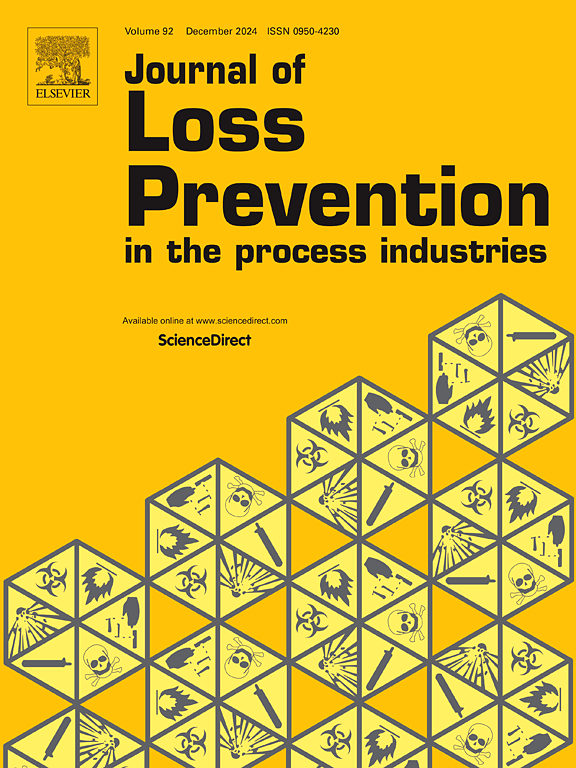4A zeolite-loaded bicarbonate as an anti-caking dust explosion inhibitor
IF 3.6
3区 工程技术
Q2 ENGINEERING, CHEMICAL
Journal of Loss Prevention in The Process Industries
Pub Date : 2025-02-03
DOI:10.1016/j.jlp.2025.105577
引用次数: 0
Abstract
This study aims to improve the explosion suppression performance of bicarbonate powders (KHCO₃ and NaHCO₃) against combustible dust and enhance their anti-caking properties by loading bicarbonate onto the surface of 4A zeolite. Using wet impregnation and evaporative crystallization, KHCO₃ and NaHCO₃ particles were successfully attached to the tetrahedral structure of 4A zeolite, resulting in composite dust explosion inhibitors, Zeolite-KHCO₃ and Zeolite-NaHCO₃, with large specific surface areas. The inhibition efficiencies of bicarbonate and 4A zeolite-loaded bicarbonate on wheat starch explosions were tested using a 150 cm Hartmann tube. The anti-caking properties of the composite were also evaluated under high humidity conditions. Results showed that Zeolite-KHCO₃ exhibited enhanced explosion suppression efficiency compared to KHCO₃, with a minimum complete inerting ratio (MIR) of 0.05, while Zeolite-NaHCO₃ exhibited an MIR of 0.12, consistent with NaHCO₃. The accelerated caking tests revealed that in contrast to KHCO₃ and NaHCO₃, Zeolite-KHCO₃ and Zeolite-NaHCO₃ exhibited superior anti-caking properties due to the drying effect of zeolite, with a caking rate of less than 0.1. These findings indicate that 4A zeolite-loaded bicarbonates can drastically reduce the caking tendency of bicarbonate while maintaining or enhancing its explosion suppression efficiency.

4A沸石负载碳酸氢盐作为抗结块粉尘爆炸抑制剂
通过在4A沸石表面加载碳酸氢盐,提高碳酸氢盐粉(KHCO₃和NaHCO₃)对可燃性粉尘的抑爆性能,提高其抗结块性能。采用湿浸渍和蒸发结晶的方法,将KHCO₃和NaHCO₃颗粒成功地附着在4A沸石的四面体结构上,得到了比表面积大的复合抑尘剂zeolite -KHCO₃和zeolite -NaHCO₃。用150 cm哈特曼管测试了碳酸氢盐和装载4A沸石的碳酸氢盐对小麦淀粉爆炸的抑制效果。在高湿条件下对复合材料的抗结块性能进行了评价。结果表明,沸石-KHCO₃比KHCO₃具有更高的抑爆效率,最小完全惰性比(MIR)为0.05,而沸石-NaHCO₃的MIR为0.12,与NaHCO₃一致。加速结块试验表明,与KHCO₃和NaHCO₃相比,沸石-KHCO₃和沸石-NaHCO₃由于沸石的干燥作用,具有更好的抗结块性能,结块率小于0.1。上述结果表明,负载4A沸石的碳酸氢盐可以显著降低碳酸氢盐的结块倾向,同时保持或提高碳酸氢盐的抑爆效率。
本文章由计算机程序翻译,如有差异,请以英文原文为准。
求助全文
约1分钟内获得全文
求助全文
来源期刊
CiteScore
7.20
自引率
14.30%
发文量
226
审稿时长
52 days
期刊介绍:
The broad scope of the journal is process safety. Process safety is defined as the prevention and mitigation of process-related injuries and damage arising from process incidents involving fire, explosion and toxic release. Such undesired events occur in the process industries during the use, storage, manufacture, handling, and transportation of highly hazardous chemicals.
文献相关原料
公司名称
产品信息
阿拉丁
NaHCO3
阿拉丁
KHCO3

 求助内容:
求助内容: 应助结果提醒方式:
应助结果提醒方式:


